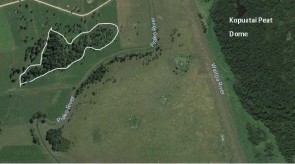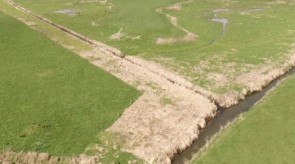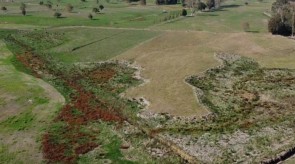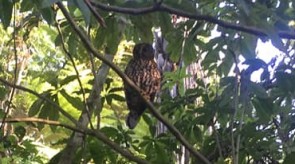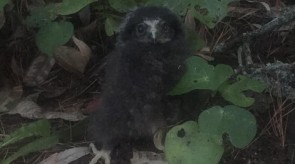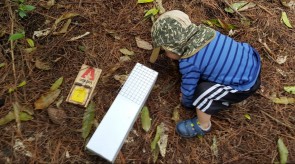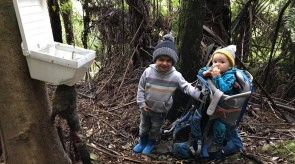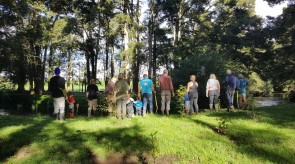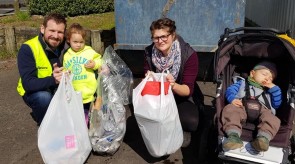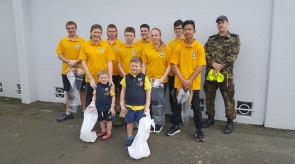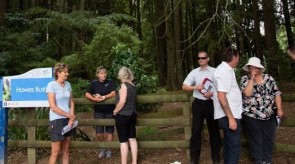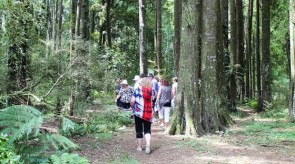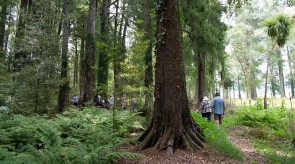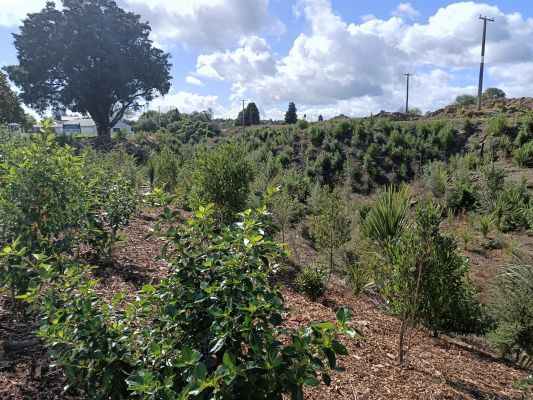Awarua Farm
Awarua Farm lies near the confluence of the Piako and Waitoa Rivers, adjacent to the Kopuatai Peat Dome. There is a dense patch of fenced kahikatea surrounded by sparse kahikatea trees that have been grazed underneath. Until recently, the understorey and mid-storey were dominated by privet and other weeds. The proximity of this site to Kopuatai and the presence of kahikatea canopy mean this area is prime for restoration. This area has received 6 months of intensive weed management involving the drilling of the privet before winter 2023 planting of 4,500 plants. The first 1500 plants were planted on July 8th in a community planting day with around 40 volunteers. The remaining plants will be installed in spring 2023 when the site dries out a bit.
Waiharakeke and Friends
Sing Family Farm
This project involves a few neighbouring farms including David Sing’s farm, a dairy farm at Wilton Rd, Tatuanui. David has been planting pieces of wetland and forest on his farm for around 20 years. This was accelerated a couple of years ago in when he met Dr Rebecca Eivers, a freshwater ecologist, at a NZ Landcare Trust field day at Horsham downs. It was about end of drain treatment systems. David has engaged Dr Eivers in 2019 to design and plant a constructed wetland on a small watercourse with the aim of measuring and documenting the effects on water quality. Another neighbour, Wayne Berry, is also employing Dr Eivers and planting immediately upstream trying some different strategies to reduce contaminants reaching the stream. David has always wanted to plant the area adjacent with lowland forest species and has now been planted over the past 3 successive winter seasons. The old duck pond will be planted with raupo to attempt to create matuku (Australasian bittern) and other wetland bird species habitat. This project has been put onto a firm footing with the engagement of a local forest regeneration ecologist, Nathan Smith, of Titoki Landcare. In 2022, we attempted to organise a community planting day on June 11 to show off the work that has been done to date and to engage with neighbouring farms on the potential of such projects but unfortunately the weather worked against us.
Waiorongomai Valley Farm
Johan Van Ras’ family farm (Waiorongomai Valley Farm) is just down the road from Davids on SH27. The family has retired 4.5 ha of land that was often too wet to graze and planted over 8,000 native plants in its place. Johan and David are both involved in a Carex spp. drain trial initiated in 2021 by Waikato Regional Council which involves planting Carex sedges along both sides of farm drains. The purpose of this is to shade out invasive weeds, reduce water temperature, reduce nutrient input, provide habitat for fauna and overall reduce the need to dredge drains. This initiative is comparatively cheap, practical and achievable and could be more widely implemented. Johan and David hope to turn these projects into a showcase for farmers in the wider area to encourage the conversion of unproductive land into wetlands and forests which would also serve to meet farm management mitigation requirements. Most of these efforts to date have been self-funded with some assistance from the Waikato Regional Council Environmental Initiatives Fund and Valder Trust.
In 2023 with help from Waikato Regional Council and Riverwatch, three mighty Waka water monitoring systems have been installed in farm waterways near Tatuanui to measure the impact the Carex spp. plantings are having on water quality. The three waka are in the Te Puninga, and Donald Streams and one in the Waiharakeke Stream. The two in small streams are part of the Carex spp. trials, which have also had eDNA testing done and electro fish sampling undertaken to get a baseline understanding of what is living in our waterways. The Waiharakeke one is to get some baseline data from the wider catchment. All wakas need time to see the effects of seasons, weather events and other variable events. These waka measure pH, temperature, turbidity, conductivity and dissolved oxygen. These waka will serve to build a picture of the tributary waterways in our sub-catchment (Waiharakeke) of the Piako. This will also help to start getting our catchment community aware of the terminology of water sampling including what terms like DO and turbidity mean and how we can mitigate them.
Te Miro Pest Control: A Community Effort to Restore Native Wildlife
About Four Years Ago: The Beginning of Te Miro Pest Control
In Te Miro, a small but dedicated community gathered to discuss the potential for pest control in the Waterworks Road Reserve. The initial consensus was to go toxin-free due to public concerns and the area's status as a water reserve. However, John Innes, a noted ecologist, warned that no community group had successfully reduced the rat trapping index below 10% without the use of toxins.
Fortnightly Trap Clearing and the Challenge of Rat Control
The community committed to clearing traps every fortnight, with some members even doing it more frequently. Our Groups diligently monitored the rat trapping footprint indexes, and Trap NZ provided a summary of the trap numbers. The Waikato Regional Council (WRC) supported the effort by providing grid coordinates and advice on trap installation.
The trap setup included:
- Two Victors at every 75x75m location.
- DOC200s and Trapinators for possums at every third location, every third row, or every 225m.
This extensive network targeted not only rats but also stoats, ferrets, weasels, hedgehogs, and rabbits.
Initial Bird Counts and Observations
Catherine Hay conducted bird counts, but the results were discouraging, with not much worth counting initially. However, some species like fantails, kereru, tui, and ruru were occasionally observed. Despite the efforts, there was a strong feeling that bird life had not significantly increased. The community’s efforts were suppressing rat populations but not sufficiently enough to allow birds to fledge successfully.
Expert Advice and the Introduction of Toxins
Expert advice suggested that toxins were necessary to achieve the desired ecological balance and support native bird breeding. Acknowledging this, the Matamata-Piako District Council (MPDC) funded the purchase of 286 Philproof mini bait stations, providing enough resources for one bait drop.
Future Plans: Increasing the Frequency of Bait Drops
The community plans to conduct up to four bait drops per season, informed by pre- and post-footprint tracking. They anticipate carrying out bait drops every 6-8 weeks, depending on the tracking results. The focus is on using Pindone rat pellets, which are sub-lethal to possums, to ensure a targeted approach.
Challenges and Considerations
While Pindone is effective, other toxins like Brodifacoum and Coliceferol (double tap) were considered but found to be problematic due to their moisture uptake, loss of palatability, and lack of a good antidote for dogs.
Acknowledgment and Funding
The Te Miro Pest Control project acknowledges the generous funding and support from the MPDC and the Waikato Regional Council Small Scale Community Initiatives Fund. This support has enabled the purchase of bait stations and the initiation of toxin-based pest control. The community remains committed to enhancing the local ecosystem and supporting native wildlife through continued efforts and adaptive management strategies.
For more information about the project and to see the progress, visit our Trap NZ project page.
Join Us
We invite all community members and interested parties to join us in our mission to restore the native wildlife in Te Miro. Your support and participation are crucial to the success of this project. Together, we can make a significant impact on our local environment.
If you are interested in becoming involved in predator pest control work at the Te Miro Mountain Bike Park on Waterworks Rd then please contact Jude Tisdall or Warren Smith, the coordinators.
We are also very keen to promote and assist with the setting up of additional pest control projects around the Matamata Piako District so please feel free to contact Jude if you have any ideas.
Jude Tisdall
mob 021 947 815
jude.s.tisdall@gmail.com
Projects working out in the Piako Catchment
Connecting the Waitoa
In 2018, we initiated a project called “Connecting the Waitoa” alongside NZ Landcare Trust and Waikato Regional Council. The project seeks to reconnect the remaining lowland forest remnants and wetlands linked by the Waitoa River between Waharoa and Waitoa. Connecting the Waitoa is a collaboration between industry, landowners and councils.
Keep New Zealand Beautiful Annual Clean Up Week
Keep New Zealand Beautiful Clean Up Week is an annual clean up event between Keep Morrinsville Beautiful and the Piako Catchment Forum.
Each September we work together to pick up rubbish throughout the Morrinsville township. Whilst we clean our home we also work together building relationships and connection to each other and our town.
For more information on Clean Up events contact Piako Catchment Forum
Friends of Hawes Bush
Hawes Bush is a Reserve situated in the heart of Waharoa near Matamata. This is 2.2 Ha area with a large stand of mature Kahikatea. The local community is working together to improve the mana of this area, including weeding and planting.
This is an informal group of about 6 - 8 regulars who are undertaking weeding and planting within this precious lowland kahikatea forest fragment. They are making great progress but there is still plenty of work to do aimed primarily at the re-establishment of the natural understory as close as is practical to what it would have been in pre human times. In the future they hope to help bring about the construction of a good quality loop track through the Bush.
The project is part of a bigger Piako Catchment Forum project called Connecting the Waitoa. This aims to restore and connect lowland forest fragments along the Waitoa River between Waharoa and Waitoa villages.
This group would like to get onto a regular 4 weekly session on a Friday morning. The first Friday session will be on 2 October. We will start at 9am and be there till 12pm. People can suit themselves how long they come for though. Any help is most welcome.
It would be great to hear from anyone who might be interested in being involved. Hawes Bush is a lovely place to spend a bit of time chasing down weeds. The site is flat and easily accessible. There are a range of different species and sizes of weeds to suit different preferences.
For more information about this project or to get involved please contact Jude on 021947815 or email her at jude.s.tisdall@gmail.com
Weedbusters
With the guidance and orgainsation of Jude and Ron a team of volunteers get together each month to weed out pest and invasive species in native remnants within our catchment and neighbouring areas.
For more information of weedbusters check out the weedbuster website: https://www.weedbusters.org.nz/
Or contact Jude on 021 947 815 or email jude.s.tisdall@gmail.com
Morrinsville Allen St Gully
Allen Street Gully is a planting project in the heart of Morrinsville Township. This is a high traffic area for both local and through traffic situated on the Morrinsville by pass. This planting has been undertaken by a small group of highly motivated Morrinsville vollenteers. Planting began in 2018 with a second year of planting in 2019. With a wide range of eco-sourced natives this will provide long term soil stability along with habitat for bird and insect life. This site has proven to be a difficult site due to terrain, historic rubbish and other factors. Projects like this take serious commitment and maintance over serveral years, including weeding and ideally pest control. However, projects like this provide postive outcomes for the community and environment for decades to come.
For more information about this project or support to start your own please contact the Piako Catchment Forum.
Unlocking Curious Minds - Te Kura o Waharoa
The Piako Catchment Forum, in partnership with Manaaki Whenua-Landcare Research and Te Kura o Waharoa, has obtained funding through the Ministry for Business Innovation and Employment "Unlocking Curious Minds" to equip the tamariki of Waharoa with environmental science and ecosystem management techniques enabling them to act as kaitiaki of their ngahere.
Waharoa and its environs are home to some of the finest kahikatea forest remnants on the Hauraki plains. The long-term preservation of these taonga ngahere depends on the tamariki of Waharoa re-engaging with their local environment. Our project uses environmental science as a vehicle to restore whakapapa connections between Te Kura o Waharoa tamariki and their local forest ecosystems.
The project has three main science components:
- Student-designed resources for native and weed plant species identification
- Collection, establishment, and monitoring of biocontrol agents for a major forest weed
- Surveys for the presence of native long-tailed bats (pekapeka) in forest remnants near Waharoa.
Ultimately we hope to empower the tamariki as champions for kaitiakitanga in Waharoa and the broader Piako catchment by providing them with the tools they need to a) manage their forest ecosystems and native species. And b) communicate their knowledge to their peers, whanau and the wider community.
For more information about this mahi please email Norm at kaurigiant@gmail.com



